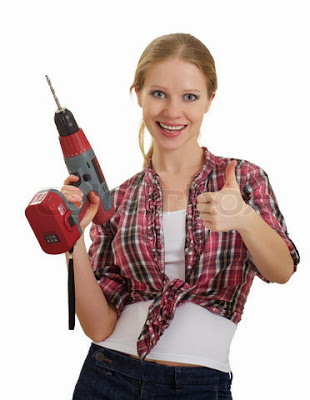Many woodworkers even have two (or more) cordless drills. This reduces the number of bit changes so you can have your pilot/countersink in one and your driver bit in the other. It also allows you to keep one lightweight drill and one heavyweight. The smaller and lighter-weight drills are great when you need to drill a lot of small holes or drive small screws, but you'll need more power for drilling larger holes in hardwood.
Know the Features
What it really comes down to is finding a drill (or drills) with the power you need and the comfort you desire.Comfort
This is a personal preference. If you can, hold several drills and pretend to drill some holes with them (looking funny in the store for a few minutes will pay off with years of comfort). Is the handle comfortable, or too big, or too small? Is the head angle (the relationship of the driver to the handle) correct for you? How easy is it to change direction? In most cases, you'll find a few that are much more comfortable to you than the others.Power
Higher-voltage batteries provide more power. Although more expensive, NiMH batteries appear to have a longer run time per pound than ni-cad, but the jury is still out on this one.Longevity
The ampere-hour rating, abbreviated Ah, gives you an indication of how long you can go between charges. Higher Ah ratings won't provide any more power, but their charges last longer, generally in direct proportion to the rating number (a 3 Ah battery will last twice as long as a 1.5 Ah). Higher Ah batteries usually don't weigh any more than lower Ah batteries.Speed
Higher speeds drill holes faster, and usually cleaner, than slower models. Be especially careful of larger, more powerful drills, which may be geared down for heavy use and lacking the higher speeds that are better for everyday small bits.Weight
Although a drill may seem light enough in the store, think about holding it at a difficult angle for a long period.Don't get carried away by the "Tim Taylor Syndrome" and get the biggest, most powerful cordless drill you can afford. For one thing, it'll weigh much more than moderate 9.6- to 14.4-volt drills. For another, when you're working in the shop, an outlet and perhaps a drill press are right at hand for those really large holes. The lighter weight of moderate-size drills will make your arm happy for years.
Drive train
The drive system should include:- A two-speed gearbox so you have the option of high speed or high torque.
- Smooth speed control at the trigger so you can start screws or bits slow and then speed up (electronic speed controls, especially those that provide constant rotation speed, are particularly good).
- An electric brake for safety and so you can move on to the next hole or screw quickly.
- A multitorque clutch so you can apply just enough torque to drive a screw home without stripping the screw or hole.
Handle style
T-handles are the most popular because they're better balanced and fit into tight spaces easier. While you can always use a second hand behind the motor on a T-handle, a pistol grip gives you a lot of one-handed power so you can to push directly in line with the bit. Some rubber on the handle helps your holding power as well.Side handle
Need some extra power and control? An optional side handle will let you really apply some force.Chuck
With the exception of a few impact/hammer drills and some bargain-basement specials, everything's keyless now and it's a good thing, too! You want one that loosens and tightens easily and that gets a solid hold on the bit. You'll also need to decide between 1/2-inch and 3/8-inch capacity. One-half-inch chucks are necessary for some larger bits, but they weigh more than the 3/8-inch chucks. Most woodworkers choose 3/8-inch chucks.Chuck lock
An automatic chuck lock is a convenient feature on keyless chucks. When you turn the outer ring of the chuck to change bits it automatically locks the chuck. Makes doing this three-handed operation much easier with two hands.Accessories
If you have a need for multiple cordless tools (the flashlights that use these batteries are really great), having interchangeable batteries is a big plus. In this case, choose a drill that's part of a coordinated line of tools.Batteries
The heart of cordless tools: The battery pack that comes with a battery-powered tool is actually a collection of battery cells, usually AA size, but 1.2-volt instead of the standard 1.5-volt AAs we use for most consumer electronics.Batteries work by converting chemical reactions to electricity. A battery comprises two metals immersed in a liquid electrolyte. In a ni-cad the metals are nickel and cadmium. When the battery is charged, the nickel is oxidized (similar to copper turning green). When the battery is used, the nickel is reduced and the cadmium is oxidized by electron flow between the two. This flow of electrons is what produces electrical flow through the motor of a tool.
A NiMH (nickel metal hydride) battery is similar except that it uses metal hydrides instead of cadmium. Metal hydrides have the potential to produce power for longer periods than cadmium. These batteries last significantly longer in small electronic devices, such as digital cameras, but the jury is still out as to whether this holds true for higher-power applications such as cordless tools. Used NiMH batteries are not considered a hazardous waste, as are used ni-cad batteries.
